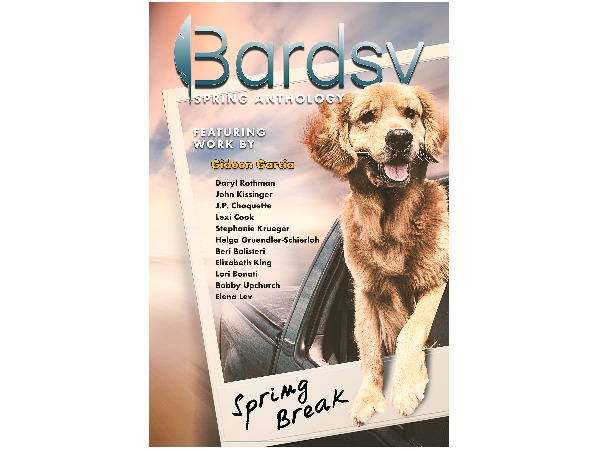😃 Subscribe for Weekly Posts:


My first year in retirement was supposed to be blissful. Instead, I was waiting in line to order a coffee before waiting in traffic, before waiting in a lawyer's waiting room, before waiting in line at the grocery store to pick up dinner for two. Yes, two. She hasn’t moved out yet.
How is a deer like a divorce? Gideon Garcia will show you as he drives home a life-long love of language in "Deer and Metaphors", his award-winning submission to our Spring Anthology contest. You'll probably want to come along for the ride.
“Deer and Metaphors” offers a glimpse into the mind of a man struggling to comprehend the abrupt conclusion of his forty-year marriage. Shocked to the core, the protagonist reels with a multitude of questions, most of all, “Why?”
Given the degree of emotional resonance in this narrative, we experienced a mild shock of our own when we learned the author is a young man writing about an older one. Gideon's goal with this story was to “look at an experience that [he has] never had, through the eyes of a man [he has] never been.” As you will discover, he accomplishes this goal with seeming ease.

I love metaphors. Metaphors are sugar. Similes are for simpletons, metaphors are high art. Doesn't it seem like true art should take some work to decipher? Or should we be allowed to paint a prisoner dragging a ball and chain where the ball has been replaced by a cell phone and
call it art?



I love metaphors. Metaphors are sugar. Similes are for simpletons, metaphors are high art. Doesn't it seem like true art should take some work to decipher? Or should we be allowed to paint a prisoner dragging a ball and chain where the ball has been replaced by a cell phone and
call it art?

Under the language dimension of our Publishability Index, you’ll find that great stories include “choices that stimulate interest and reaction, a distinctive style evoking a mood or tone and precise, purposeful or impactful construction throughout.”
“Deer and Metaphors” teems with all of the above, including, as you probably expected from the title, dynamic figurative language. First, the narrator declares his utter contempt for similes, a point he illustrates by saying “I wish I could cut [similes] out of the conversation as a chef filets a fish.”
The character channels reactions to his pending divorce into disdain for similes. Much of the language - and even syntax - in this story is stewed in ire, representative of someone coping with the complete upheaval of life as they know it. Take, for instance, the adjectival repetition of “dumb” in the following sentence:
They permeate our dumb minds' attempt to arrive at dumb conclusions about dumb
things that happen to our dumb lives.
While he is referring to similes at first, it’s as if everything else has become “dumb” by association. This reflects his perception of the world, as colored by his frustration and disappointment.


I feel like I’m asking a lot of questions. Our marriage was hardly like the wilderness. Ugh. Similes. Our marriage was hardly the wilderness.
“Deer and Metaphors” is a story told through stream of consciousness, a form that suits the character's mental state. He is in no position to tell a narrative in a traditional way. His mind is overflowing with emotion, and there is a natural progression from one thought to the next.
What is the effect of this? Consider one of the reasons Gideon is passionate about writing:
It is the most accessible form of human expression. It removes a few of the layers that we usually have to work through when someone is communicating with us. I think when these superfluous layers are removed, communication is more direct and visceral.
“Direct” and “visceral” perfectly capture the style of this story. It’s raw, and the result is that we feel emotional intimacy with the character. There is no filter between us and him.
To borrow a few more words from our Publishability Index, a great character is “fleshed out” in a way that makes them “come to imagined life.” By telling the story through a stream of consciousness, Gideon makes this character feel real. It’s as if he is venting to us, or we are reading an entry in his journal.
Another literary device that Gideon utilizes to great effect is the rhetorical question. As he struggles to understand how he has arrived at this current point, the speaker’s head buzzes with questions:
What wasn't happy about us? We were so comfortable.
I say "we" because there was never any indication that she was not happy. What does that mean anyway? Happy. Isn't that too small a word to describe living? When you're a toddler grasping your dad’s pointer and middle finger with your whole hand, happiness is so attainable, describable. You don't have ice cream and then all of a sudden you do and you're happy.
When you get older happiness is not measured that way. It's more about homeostasis. It's more about, is everything handled? Did you pay that bill? Did you get there on time? Have you hit your requirements? Did you pick up the ice cream your loving wife of forty years asked you to pick up?
I say "we" because there was never any indication that she was not happy. What does that mean anyway? Happy. Isn't that too small a word to describe living? When you're a toddler grasping your dad’s pointer and middle finger with your whole hand, happiness is so attainable, describable. You don't have ice cream and then all of a sudden you do and you're happy.
When you get older happiness is not measured that way. It's more about homeostasis. It's more about, is everything handled? Did you pay that bill? Did you get there on time? Have you hit your requirements? Did you pick up the ice cream your loving wife of forty years asked you to pick up?
As we age, the concept of happiness can become more complicated, and somewhat elusive. The story suggests it has more to do with stability, maintaining balance and finding the right answers to a long, perhaps never-ending, series of questions.
The reader comes to understand the central metaphor of the story, deer, as the unexpected, the unavoidable, the events that hit us out of nowhere. They shatter the windshield through which we view the world. The speaker wonders:
Why are deer so much like rats? I feel like there didn't use to be so many deer in this
country. You don’t really think about them or care about them until they’re right in front of you, then they’re the only thing that matters.
In this way, a deer is like a divorce. One moment it’s the furthest thing from your mind, and the next, it’s jumping out at you, upsetting the balance of your car on the road, and your life. It can kick you in the chest, “right in the spot where it feels like a cave when your wife slides you a stack of papers covered in eloquently written painful words.”
It is a confrontation with a literal deer that propels this character towards acceptance. A chance occurrence marks a turning point in his way of thinking, both about his divorce and the nature of life.
Gideon's win of our latest contest was part of a short-term strategy on a path to writing success. He is currently working on a novel titled Yellow Means Go, a non-fiction book on the subject of the immigration system in the United States, as well as a few more short stories that he plans to submit to contests.
When asked what advice he might offer to a writer who is feeling stuck, Gideon said to read more, because “good reading inspires good writing.” With “Deer and Metaphors,” you can certainly find excellent inspiration.
CLICK A TAB TO USE WILL.POWER
TO DO LIST:
Add tasks to your sortable list, then revel in checking them off.
SCRATCHPAD:
Cache your gems as they fall in this always accessible place.
PRIVATE JOURNAL:
Reflect on your process — good, bad and ugly — in your dated diary.
TRACKING:
Measure your progress with key writing metrics, automatically,
TO DO LIST:
Add tasks to your sortable list, then revel in checking them off.
SCRATCHPAD:
Cache your gems as they fall in this always accessible place.
PRIVATE JOURNAL:
Reflect on your process — good, bad and ugly — in your dated diary.
TRACKING:
Measure your progress with key writing metrics, automatically,
ADD DO
Show Dones
Metric:
ADD
Words
Minutes
Click anywhere to close